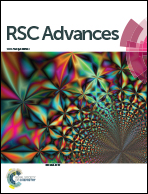A crystalline molecular gyrotop with germanium junctions between a phenylene rotor and alkyl spokes†
Abstract
Macrocage molecules with a bridged phenylene have been reported as molecular gyrotops, in which the phenylene moiety can rotate even in the crystalline state. The roles of the atoms in the junctions between the rotor and spokes in molecular gyrotops have not been clarified well. In this study, a molecular gyrotop with germanium junctions was designed and synthesized, and the differences between the properties of the germanium and silicon derivatives were discussed. Notably, a structural isomer of the cage, which is not formed in the synthesis of the silicon derivative, was formed during the synthesis of the germanium derivative. Because the long Ge–C(Ph) bond length (1.958(4) Å) was observed in the crystal structure of the germanium derivative as compared to the Si–C(Ph) bond length (1.885(2) Å) of the silicon derivative, the activation energy for the rotation of the phenylene moiety inside the crystalline state of the germanium derivative (8.0 kcal mol−1) was lower than that of the silicon derivative (9.0 kcal mol−1). Similar tendencies of temperature-dependent optical properties of the single crystal, i.e., birefringence (Δn), were observed between the germanium and the silicon derivatives, but the temperatures and magnitudes of the discontinuous change in the birefringence were different.


 Please wait while we load your content...
Please wait while we load your content...